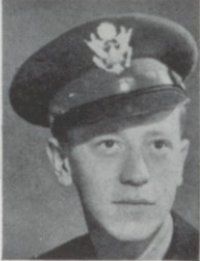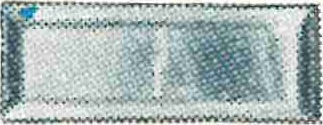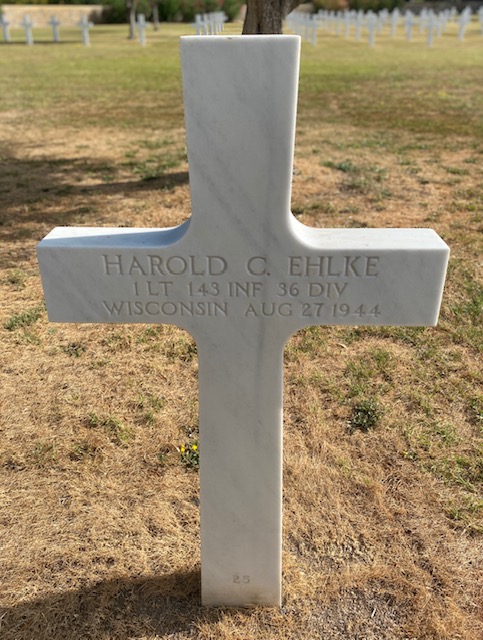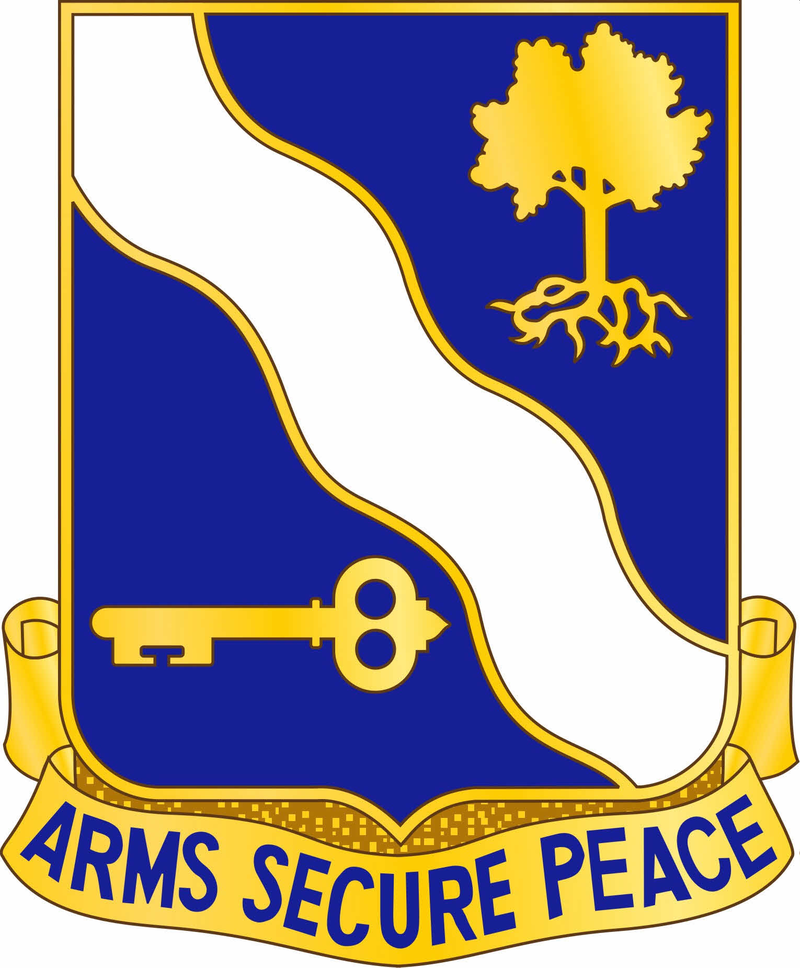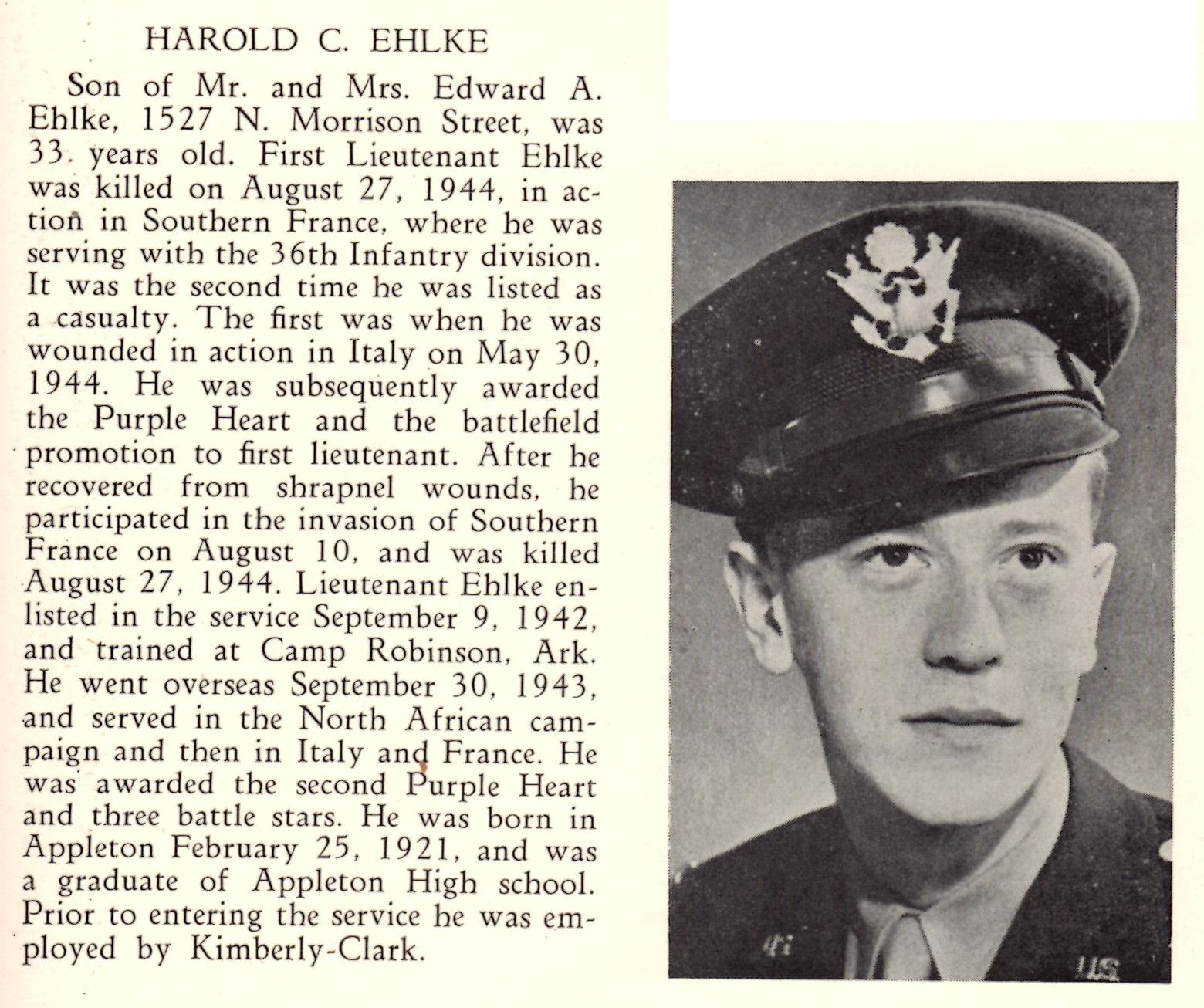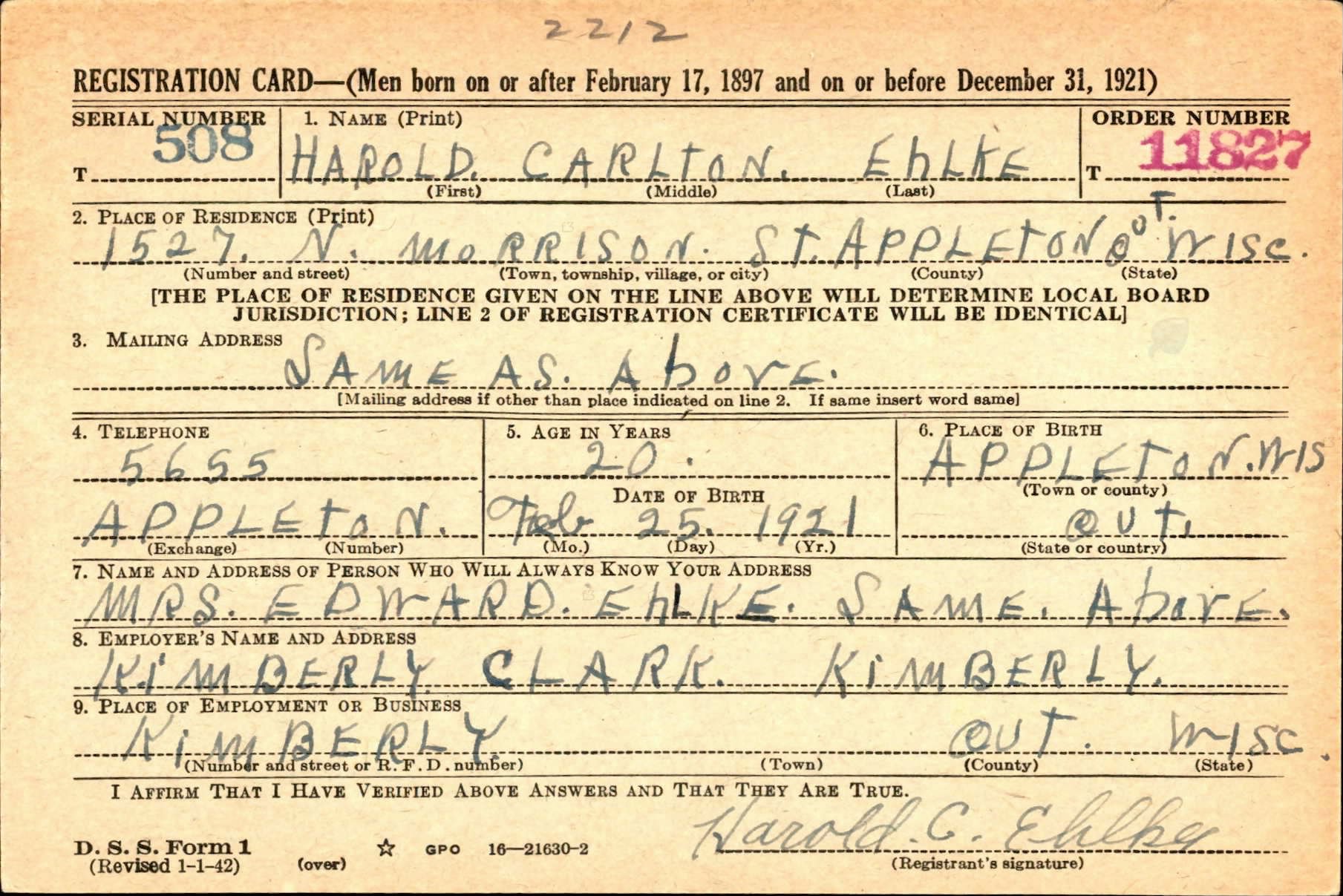|
Harold C. EHLKE
| ||||||||||||||||||||||||||
|---|---|---|---|---|---|---|---|---|---|---|---|---|---|---|---|---|---|---|---|---|---|---|---|---|---|---|
|
Source : Sandoftime
| ||||||||||||||||||||||||||
| NUMBER OF SERVICE | O-1313583 (16095905) | |||||||||||||||||||||||||
| AGE | 23 yo | |||||||||||||||||||||||||
| DATE OF BIRTH | 25 February 1921 | |||||||||||||||||||||||||
| ENLISTMENT STATE | WISCONSIN | |||||||||||||||||||||||||
| FAMILY |
Concubine : Louise KNAACK Parents : Mr. & Mrs. Edward EHLKE Brothers : Earl & Ralph Sister : Marion | |||||||||||||||||||||||||
| RANK |
| |||||||||||||||||||||||||
| FONCTION | section chief | |||||||||||||||||||||||||
| JOB BEFORE ENLISTEMENT | Employee at Kimberly-Clark |  | ||||||||||||||||||||||||
| DATE of ENLISTEMENT | 11 October 1942 Milwaukee WISCONSIN | |||||||||||||||||||||||||
| COMPANY | Company L | |||||||||||||||||||||||||
| REGIMENT | 143rd Infantry Regiment | |||||||||||||||||||||||||
| DIVISION | 36th Infantry Division | |||||||||||||||||||||||||
| ARMY | 7th US Army | |||||||||||||||||||||||||
| DATE OF DEATH | 27 August 1944 |
Source : Victor DANIEL | ||||||||||||||||||||||||
| STATUS | KIA | |||||||||||||||||||||||||
| PLACE OF DEATH | Condillac (Drôme) | |||||||||||||||||||||||||
| CEMETERY TEMPORARY |
CEMTERY TEMPORARY of Draguignan N°3519 | |||||||||||||||||||||||||
| CEMETERY | RHONE AMERICAN CEMETERY and MEMORIAL of Draguignan | |||||||||||||||||||||||||
| GRAVE |
| |||||||||||||||||||||||||
| DECORATION |
| |||||||||||||||||||||||||
| ||||||||||||||||||||||||||
| STORY | ||||||||||||||||||||||||||
|
Harold was born on February 25, 1921 in Appleton, Wisconsin. He graduated from Appleton High School before finding a job at Kimberly-Clark, a company that manufactures all kinds of paper-based products especially for the medical and surgical field. He joined the US Army in September 1942 and trained at Camp Robinson in Arkansas. There he was proposed to become an infantry officer.
A year later on 30 September 1943 he set sail with his unit for North Africa, where they participated in the ongoing campaign. He then went to the Italian countryside where he was wounded and received a first Purple Heart. His actions earned him a promotion in combat as 1st Lieutenant.
The 36th Infantry Division participated a few months later in the landing of Provence with the first wave on August 15, 1944. A few weeks later on 27 August the 3rd Battailon suffered a heavy German counter-attack on the locality of Condillac, it was during this action that the 1Lt. EHLKE is fatally injured. The counterattack was eventually repelled by American troops. The defunt lieutenant will again be decorated with a purple heart which will earn him an oak leaf on that already delivered. |
Death announcement of 1Lt. Harold EHLKE in the local newspaper. Source : Jacob Paltzer | |||||||||||||||||||||||||
|
Source : Fold3 |
Source : Fold3 | |||||||||||||||||||||||||
| | ||||||||||||||||||||||||||
Activated/Activé |
Normandy/Normandie |
| 25 Nov 1940 | Days of Combat/Jour de Combat 400 |
| Casualties/Victimes 19 466 | |
Entered Combat/Entré au combat |
|
| 9 Sep 1943 Salerno | |
|
Commanding Generals/Commandants généraux Maj. Gen. Claude V. Birkhead (Nov 40 - Sep 41) |
Campaigns/CampagnesNaples-Foggia (9 Sep 43 - 21 Jan 44) Southern France (15 Aug 44 - 14 Sep 44) |
PLAN DE ROUTE DE LA CAMPAGNE - CAMPAIGN ROUTE MAP |
|
|
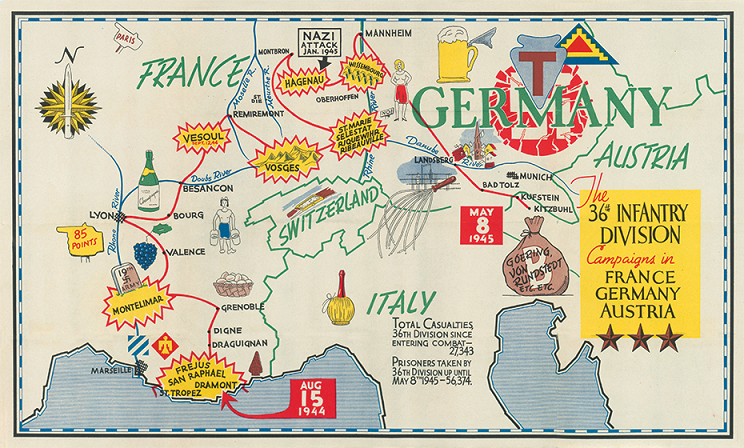 |
|
DIVISION CHRONICLEThe 36th Infantry Division landed in North Africa, 13 April 1943, and trained at Arzew and Rabat. It first saw action, 9 September 1943, when it landed at Paestum on the Gulf of Salerno. The waiting enemy launched counterattacks, but the 36th advanced slowly, securing the area from Agropoli to Altavilla. After a brief rest the 36th returned to combat, 15 November. It captured Mount Maggiore, Mount Lungo, and the village of San Pietro despite strong enemy positions and severe winter weather. This grueling campaign was marked by futile attempts to establish a secure bridgehead across the Rapido River, 1 January to 8 February 1944. After assisting the 34th Division in the attack on Cassino and fighting defensively along the Rapido River, the 36th withdrew, 12 March 1944, for rest and rehabilitation. On 25 May, the Division landed at Anzio, drove north to capture Velletri, 1 June, and entered Rome on the 5th. Pushing up from Rome, the 36th encountered sharp resistance at Magliano, but reached Piombino, 26 June, before moving back to Paestum for rest and rehabilitation. On 15 August, the Division made another assault landing against light opposition in the RaphaelFrejus area of Southern France. A lightning dash opened the Rhone River Valley. Montelimar fell, 28 August, and large Nazi units were trapped. The 36th advanced to the Moselle River at Remiremont and the foothills of the Vosges. In a grinding offensive, the Division crossed the Meurthe River, breached the Ste. Marie Pass and burst into the Alsatian Plains. The enemy counterattacked, 13 December, and the 36th held in the Colmar Pocket. On the 20th the Division resumed the attack, advancing northward along the Rhine River to Mannheim meeting heavy resistance at Haguenau, Oberhofen, and Wissembourg. The 36th moved to the Danube, 22 April 1945, and attacked the "National Redoubt" at Kunzelsau on the 30th in its final action. |
CHRONIQUE DE DIVISIONThe 36th Infantry Division landed in North Africa, 13 April 1943, and trained at Arzew and Rabat. It first saw action, 9 September 1943, when it landed at Paestum on the Gulf of Salerno. The waiting enemy launched counterattacks, but the 36th advanced slowly, securing the area from Agropoli to Altavilla. After a brief rest the 36th returned to combat, 15 November. It captured Mount Maggiore, Mount Lungo, and the village of San Pietro despite strong enemy positions and severe winter weather. This grueling campaign was marked by futile attempts to establish a secure bridgehead across the Rapido River, 1 January to 8 February 1944. After assisting the 34th Division in the attack on Cassino and fighting defensively along the Rapido River, the 36th withdrew, 12 March 1944 , for rest and rehabilitation. On 25 May, the Division landed at Anzio, drove north to capture Velletri, 1 June, and entered Rome on the 5th. Pushing up from Rome, the 36th encountered sharp resistance at Magliano, but reached Piombino, 26 June, before moving back to Paestum for rest and rehabilitation. On 15 August, the Division made another assault landing against light opposition in the RaphaelFrejus area of Southern France. A lightning dash opened the Rhone River Valley. Montelimar fell, 28 August, and large Nazi units were trapped. The 36th advanced to the Moselle River at Remiremont and the foothills of the Vosges. In a grinding offensive, the Division crossed the Meurthe River, breached the Ste. Marie Pass and burst into the Alsatian Plains. The enemy counterattacked, 13 December, and the 36th held in the Colmar Pocket. On the 20th the Division resumed the attack, advancing northward along the Rhine River to Mannheim meeting heavy resistance at Haguenau, Oberhofen, and Wissembourg. The 36th moved to the Danube, 22 April 1945, and attacked the "National Redoubt" at Kunzelsau on the 30th in its final action.
|
| SOURCE INFORMATION & PHOTO | Armydivs.squarespace.com |
|---|
| SOURCE INFORMATION & SOURCE PHOTO | Victor Daniel - Findagrave.com - Aad.archives.gov - Abmc.gov - Fold 3 |
|---|---|
| PROGRAMMER | Eric, Henri, Garrett, Clive, Frédéric & Renaud |




















